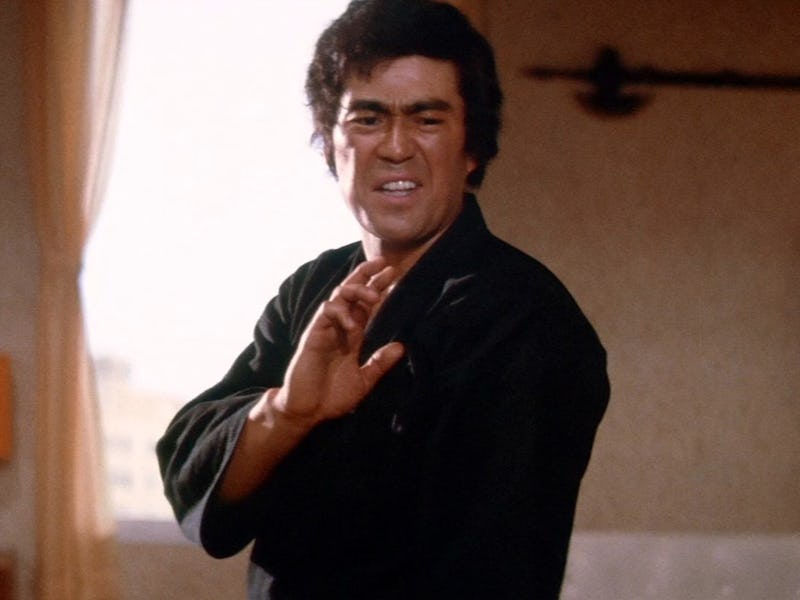Decades Ago, an Infamous Martial Arts Flick Changed Movie and Video Game History
Does the name Street Fighter sound familiar?

The popularity of Bruce Lee ignited a martial arts movie boom around the world. Many of these films were imported to America on the cheap and became exciting staples of grindhouse theaters (and the eventual subject of copious parodies). But in the mid-’70s, one man stood out in the suddenly crowded field: Sonny Chiba. And the thrilling film that made his name in the post-Lee era of the kung fu flick was The Street Fighter.
The Street Fighter’s plot isn’t too different from many of its peers: it’s a bloody tale of revenge and redemption in which the gifted Takuma Tsurugi must deal with the villainous yakuza while simultaneously honoring his own impenetrable moral code. He might be open to viciously mauling gangsters and henchmen, but betrayal and hurting the innocent? Tsurugi simply can’t stand for that. As such, much of the appeal of The Street Fighter comes from what seems like Tsurugi fighting off the entire world. Many might fall prey to greed, lust, and insecurity, but not Tsurugi. And he’s got the body count to prove it.
It’s a tremendous breakout performance for Chiba. A natural athlete and an avid student of martial arts, Chiba made his way into acting through the “tokusatsu” television series Seven Color Mask. The kaiju, mecha, and superhero-laden genre is marked by elaborate costumes and beautiful special effects, aspects that often outweigh the performances, meaning that Chiba would not find celebrity as the title superhero. That would come around 15 years later when, after appearing in countless sci-fi and crime films, he played the lead in The Street Fighter.
Chiba’s specific charisma and style would set him apart from Lee, who, though he had died a year earlier, still overshadowed the genre (just look at the sheer number of “fake Bruce Lee” films that followed his demise). While Lee was lithe and cucumber cool, Chiba was wild-eyed and brutal. He’s animalistic in The Street Fighter, constantly grunting and hissing, and when he fights, he’s not above implementing merciless pain. At one point, he steps on a downed bad guy’s hip, and the camera lingers on Chiba’s warped expression as bone-cracking sounds roar in the background.
Tsurugi is an honorable man, but he looks like he could snap at any moment.
Over the course of the film, Tsurugi wallops a man until his teeth come out, castrates someone with his bare hands, punches a bad guy so hard that we momentarily switch to an x-ray view of the man’s skull shattering, and wins the last battle by pulling a man’s throat out. In between these moments, there’s plenty of punching, shooting, and stabbing, a parade of gore that led to The Street Fighter earning the first-ever non-sexual “X” rating in the United States. This gave The Street Fighter a reputation alongside other notoriously brutal films of the era like The Texas Chain Saw Massacre, Foxy Brown, and Caged Heat, which turned 1974 into perhaps the best year ever for “exploitation” cinema.
Chiba’s career would never be the same afterward. He was consistently a leading man across a wide variety of genres, especially “jidaigeki” samurai period dramas. And with The Street Fighter, he earned a lifelong fan in genre devotee Quentin Tarantino. Pulp Fiction’s infamous Ezekiel 25:17 speech was lifted from Chiba’s Karate Kiba, and casting Chiba as the swordsmith Hattori Honzo in Kill Bill was the ultimate tribute to a martial artist and performer who inspired countless others. While in Japan for John Wick’s press tour, Keanu Reeves turned into a gushing fanboy when he met Chiba on a talk show.
As if there’s anything exploitative about this.
The legacy of The Street Fighter extends beyond cinema. Obviously, it inspired the name of the most popular fighting game franchise of all time, Street Fighter. Its brutality also influenced Mortal Kombat; x-ray shots of crushed skulls and other injuries have become a mainstay attraction in the long-running series. It’s hard not to find shades of Tsurugi’s savagery in the games, so filled as they are with colorful martial artists who relish beating the hell out of other people.
The Street Fighter isn’t for everyone. Those who prefer martial arts films less dedicated to explosions of blood should look elsewhere; Shaolin Martial Arts came out the same year and isn’t as openly gleeful about its bloodshed. That said, The Street Fighter’s power came from its ability to please multiple audiences. Those hungry for “I can’t believe they just did that!” gore would be satisfied, as would those just looking for dudes who fight for their honor and kick their way through personal problems. And it harkened the arrival of a new star whose career would eventually influence famous directors and gigantic video game franchises alike. The Street Fighter shone through the dark confines of ’70s grindhouse theater, and into the annals of pop culture history.
This article was originally published on